Comprehensive Analysis of Managerial Accounting Alternatives
VerifiedAdded on 2020/05/16
|9
|1200
|423
AI Summary
The assignment requires an evaluation of three distinct business alternatives within the context of managerial accounting. Each alternative is assessed based on its potential effects on selling prices, sales volume, variable costs, and overall profitability. The first alternative suggests increasing the product's price while incurring significant advertising expenses, posing a risk if not successful. The second alternative involves enhancing product quality and increasing sales volume, albeit with higher variable costs. The third option considers reducing the selling price temporarily to boost profitability but risks damaging perceived product quality. Ultimately, the assignment concludes that improving product quality and sales volume is recommended for optimal profitability. Additionally, activity-based costing methods are discussed to allocate overhead costs effectively, highlighting their role in enhancing decision-making processes within organizations.
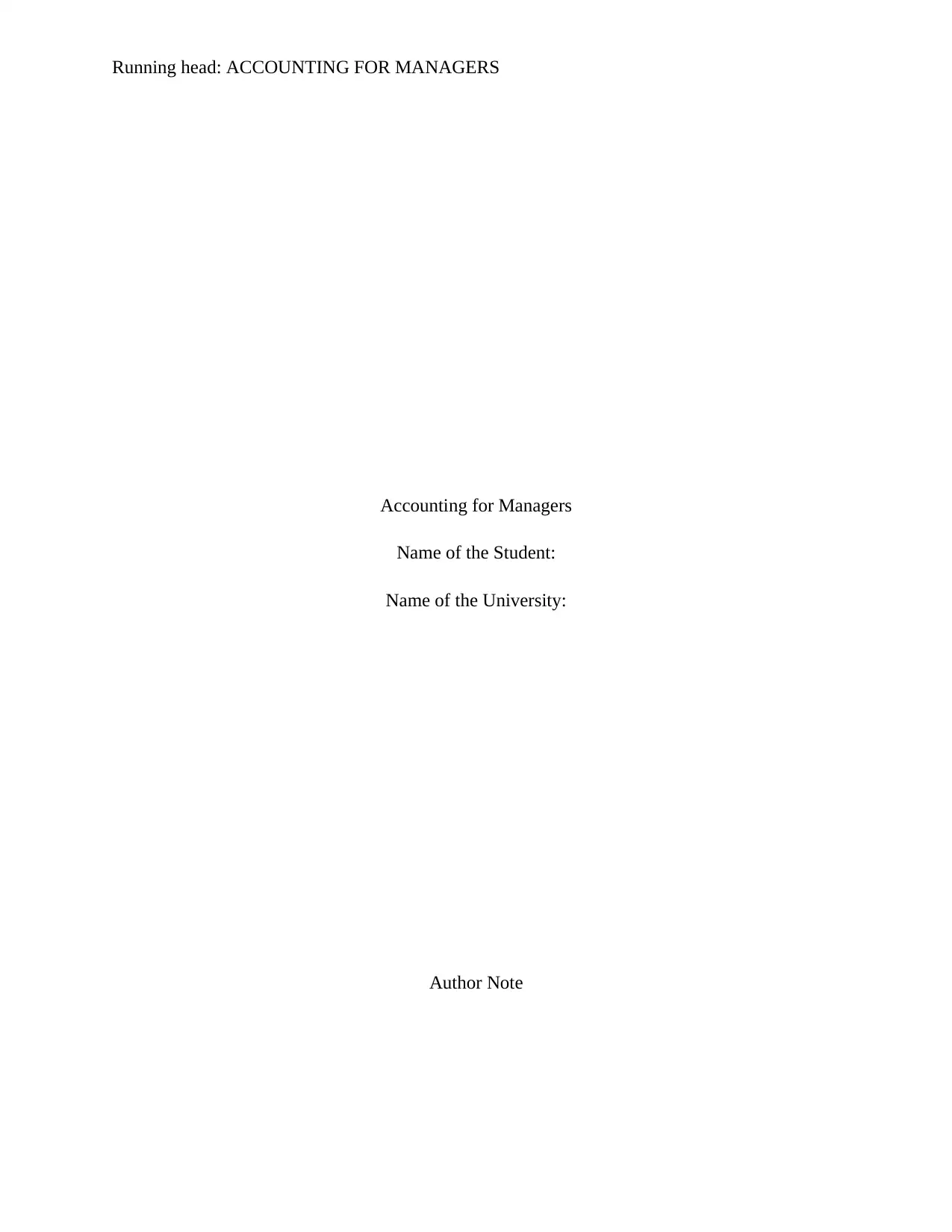
Running head: ACCOUNTING FOR MANAGERS
Accounting for Managers
Name of the Student:
Name of the University:
Author Note
Accounting for Managers
Name of the Student:
Name of the University:
Author Note
Paraphrase This Document
Need a fresh take? Get an instant paraphrase of this document with our AI Paraphraser
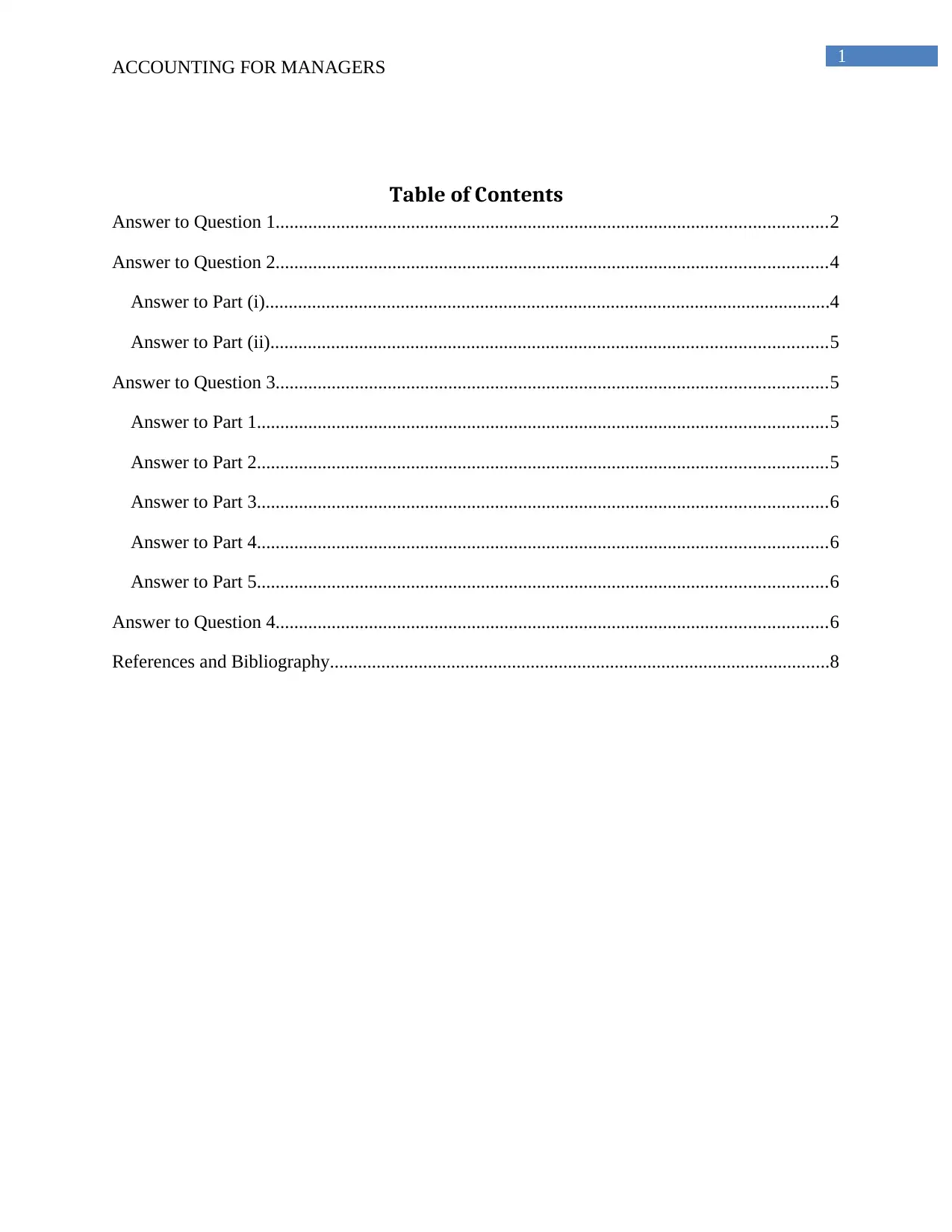
1
ACCOUNTING FOR MANAGERS
Table of Contents
Answer to Question 1......................................................................................................................2
Answer to Question 2......................................................................................................................4
Answer to Part (i).........................................................................................................................4
Answer to Part (ii).......................................................................................................................5
Answer to Question 3......................................................................................................................5
Answer to Part 1..........................................................................................................................5
Answer to Part 2..........................................................................................................................5
Answer to Part 3..........................................................................................................................6
Answer to Part 4..........................................................................................................................6
Answer to Part 5..........................................................................................................................6
Answer to Question 4......................................................................................................................6
References and Bibliography...........................................................................................................8
ACCOUNTING FOR MANAGERS
Table of Contents
Answer to Question 1......................................................................................................................2
Answer to Question 2......................................................................................................................4
Answer to Part (i).........................................................................................................................4
Answer to Part (ii).......................................................................................................................5
Answer to Question 3......................................................................................................................5
Answer to Part 1..........................................................................................................................5
Answer to Part 2..........................................................................................................................5
Answer to Part 3..........................................................................................................................6
Answer to Part 4..........................................................................................................................6
Answer to Part 5..........................................................................................................................6
Answer to Question 4......................................................................................................................6
References and Bibliography...........................................................................................................8
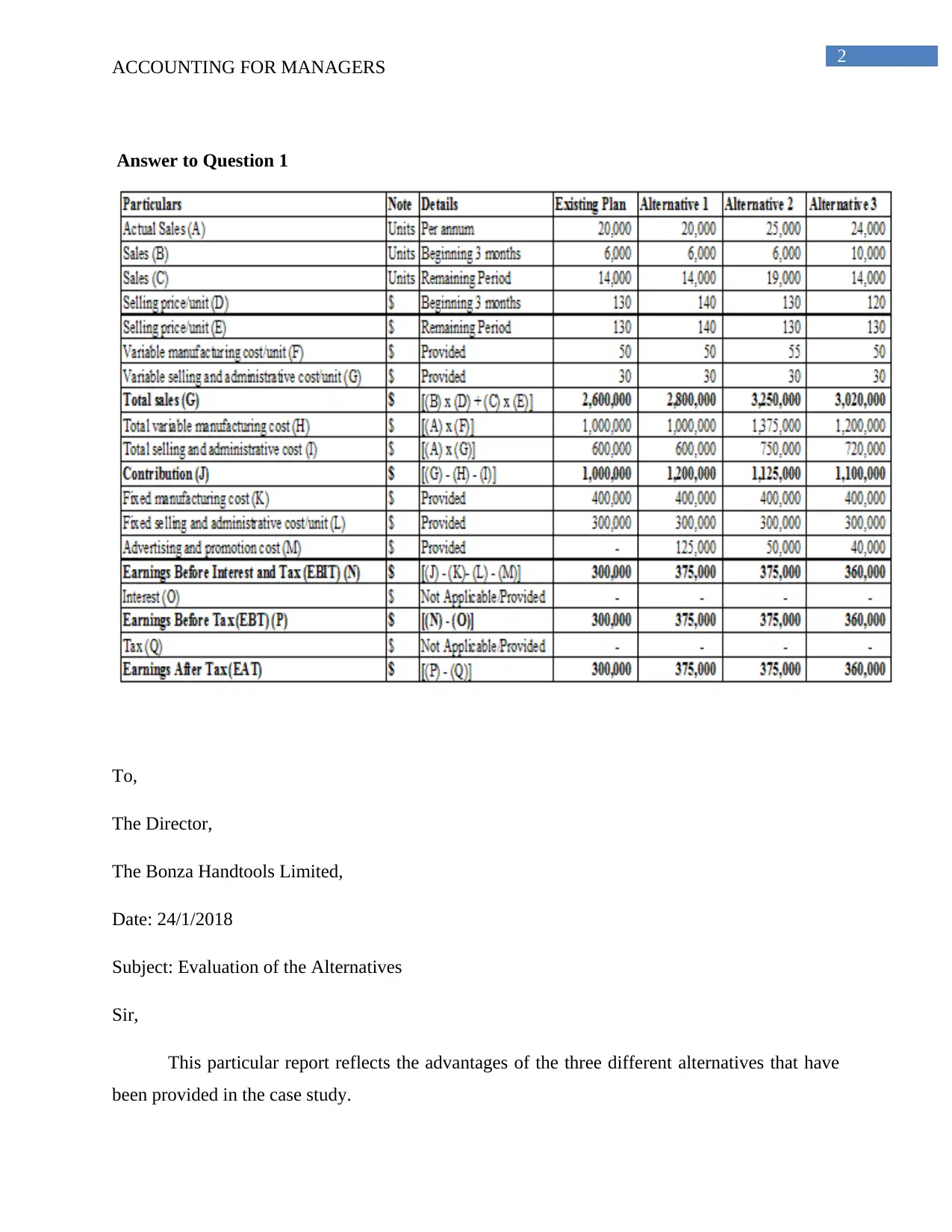
2
ACCOUNTING FOR MANAGERS
Answer to Question 1
To,
The Director,
The Bonza Handtools Limited,
Date: 24/1/2018
Subject: Evaluation of the Alternatives
Sir,
This particular report reflects the advantages of the three different alternatives that have
been provided in the case study.
ACCOUNTING FOR MANAGERS
Answer to Question 1
To,
The Director,
The Bonza Handtools Limited,
Date: 24/1/2018
Subject: Evaluation of the Alternatives
Sir,
This particular report reflects the advantages of the three different alternatives that have
been provided in the case study.
⊘ This is a preview!⊘
Do you want full access?
Subscribe today to unlock all pages.

Trusted by 1+ million students worldwide
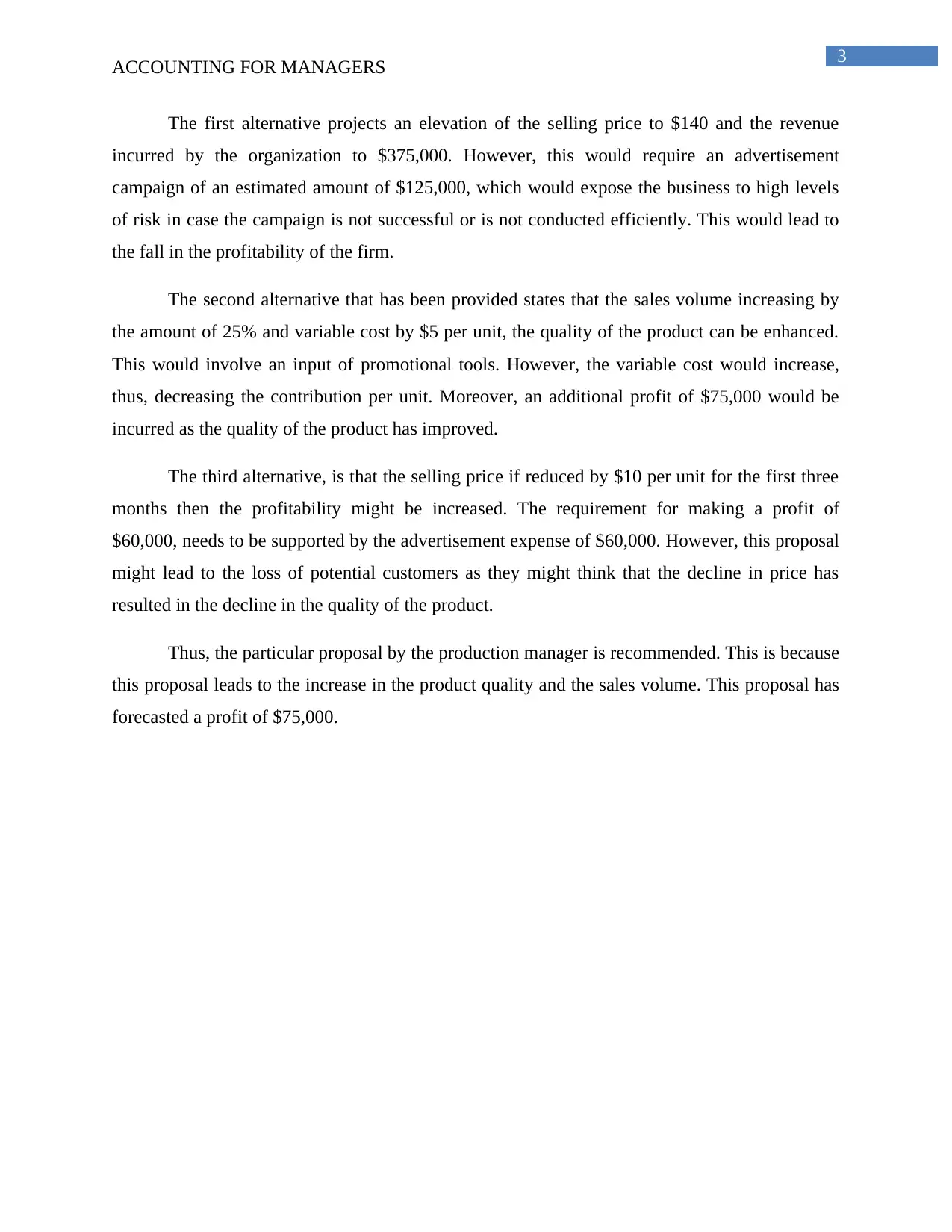
3
ACCOUNTING FOR MANAGERS
The first alternative projects an elevation of the selling price to $140 and the revenue
incurred by the organization to $375,000. However, this would require an advertisement
campaign of an estimated amount of $125,000, which would expose the business to high levels
of risk in case the campaign is not successful or is not conducted efficiently. This would lead to
the fall in the profitability of the firm.
The second alternative that has been provided states that the sales volume increasing by
the amount of 25% and variable cost by $5 per unit, the quality of the product can be enhanced.
This would involve an input of promotional tools. However, the variable cost would increase,
thus, decreasing the contribution per unit. Moreover, an additional profit of $75,000 would be
incurred as the quality of the product has improved.
The third alternative, is that the selling price if reduced by $10 per unit for the first three
months then the profitability might be increased. The requirement for making a profit of
$60,000, needs to be supported by the advertisement expense of $60,000. However, this proposal
might lead to the loss of potential customers as they might think that the decline in price has
resulted in the decline in the quality of the product.
Thus, the particular proposal by the production manager is recommended. This is because
this proposal leads to the increase in the product quality and the sales volume. This proposal has
forecasted a profit of $75,000.
ACCOUNTING FOR MANAGERS
The first alternative projects an elevation of the selling price to $140 and the revenue
incurred by the organization to $375,000. However, this would require an advertisement
campaign of an estimated amount of $125,000, which would expose the business to high levels
of risk in case the campaign is not successful or is not conducted efficiently. This would lead to
the fall in the profitability of the firm.
The second alternative that has been provided states that the sales volume increasing by
the amount of 25% and variable cost by $5 per unit, the quality of the product can be enhanced.
This would involve an input of promotional tools. However, the variable cost would increase,
thus, decreasing the contribution per unit. Moreover, an additional profit of $75,000 would be
incurred as the quality of the product has improved.
The third alternative, is that the selling price if reduced by $10 per unit for the first three
months then the profitability might be increased. The requirement for making a profit of
$60,000, needs to be supported by the advertisement expense of $60,000. However, this proposal
might lead to the loss of potential customers as they might think that the decline in price has
resulted in the decline in the quality of the product.
Thus, the particular proposal by the production manager is recommended. This is because
this proposal leads to the increase in the product quality and the sales volume. This proposal has
forecasted a profit of $75,000.
Paraphrase This Document
Need a fresh take? Get an instant paraphrase of this document with our AI Paraphraser
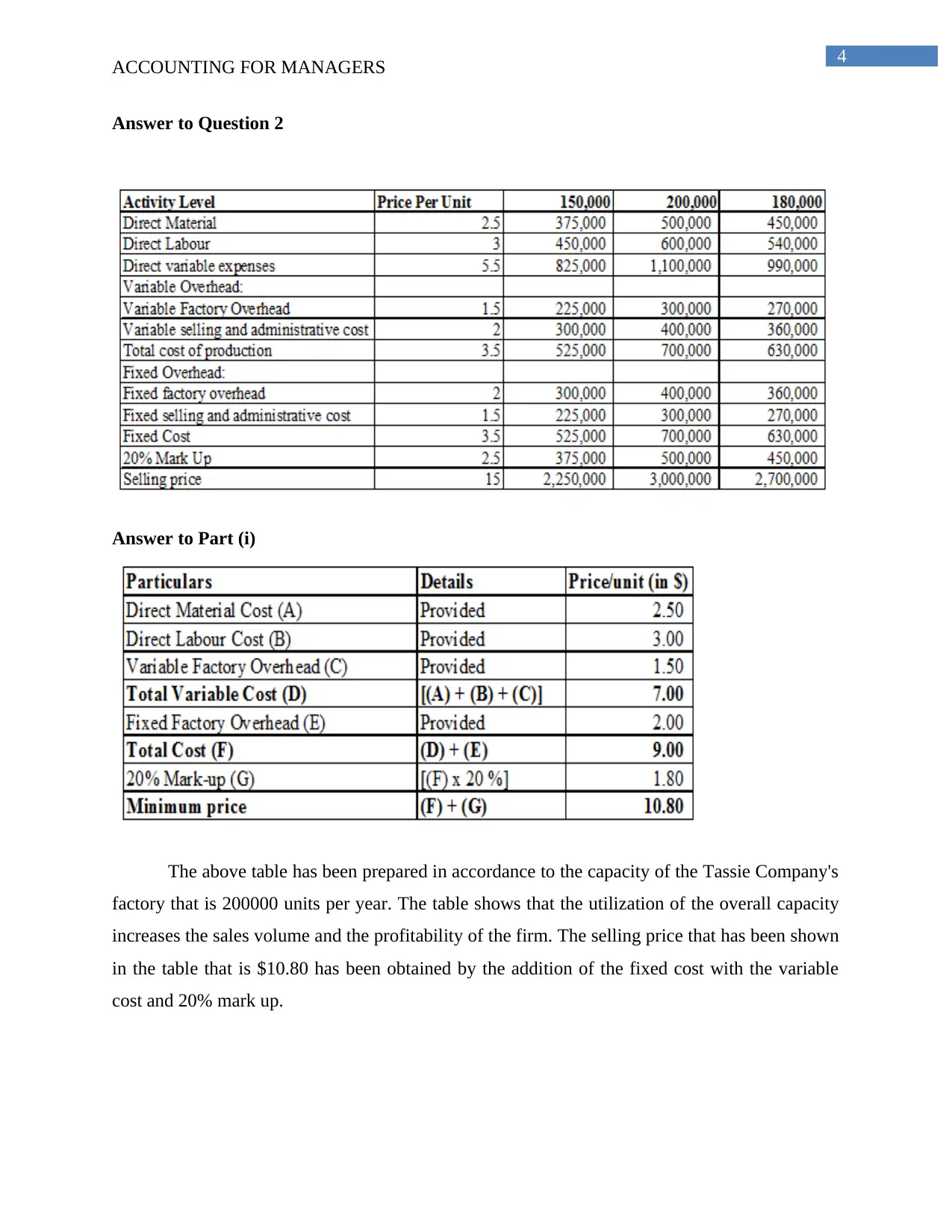
4
ACCOUNTING FOR MANAGERS
Answer to Question 2
Answer to Part (i)
The above table has been prepared in accordance to the capacity of the Tassie Company's
factory that is 200000 units per year. The table shows that the utilization of the overall capacity
increases the sales volume and the profitability of the firm. The selling price that has been shown
in the table that is $10.80 has been obtained by the addition of the fixed cost with the variable
cost and 20% mark up.
ACCOUNTING FOR MANAGERS
Answer to Question 2
Answer to Part (i)
The above table has been prepared in accordance to the capacity of the Tassie Company's
factory that is 200000 units per year. The table shows that the utilization of the overall capacity
increases the sales volume and the profitability of the firm. The selling price that has been shown
in the table that is $10.80 has been obtained by the addition of the fixed cost with the variable
cost and 20% mark up.
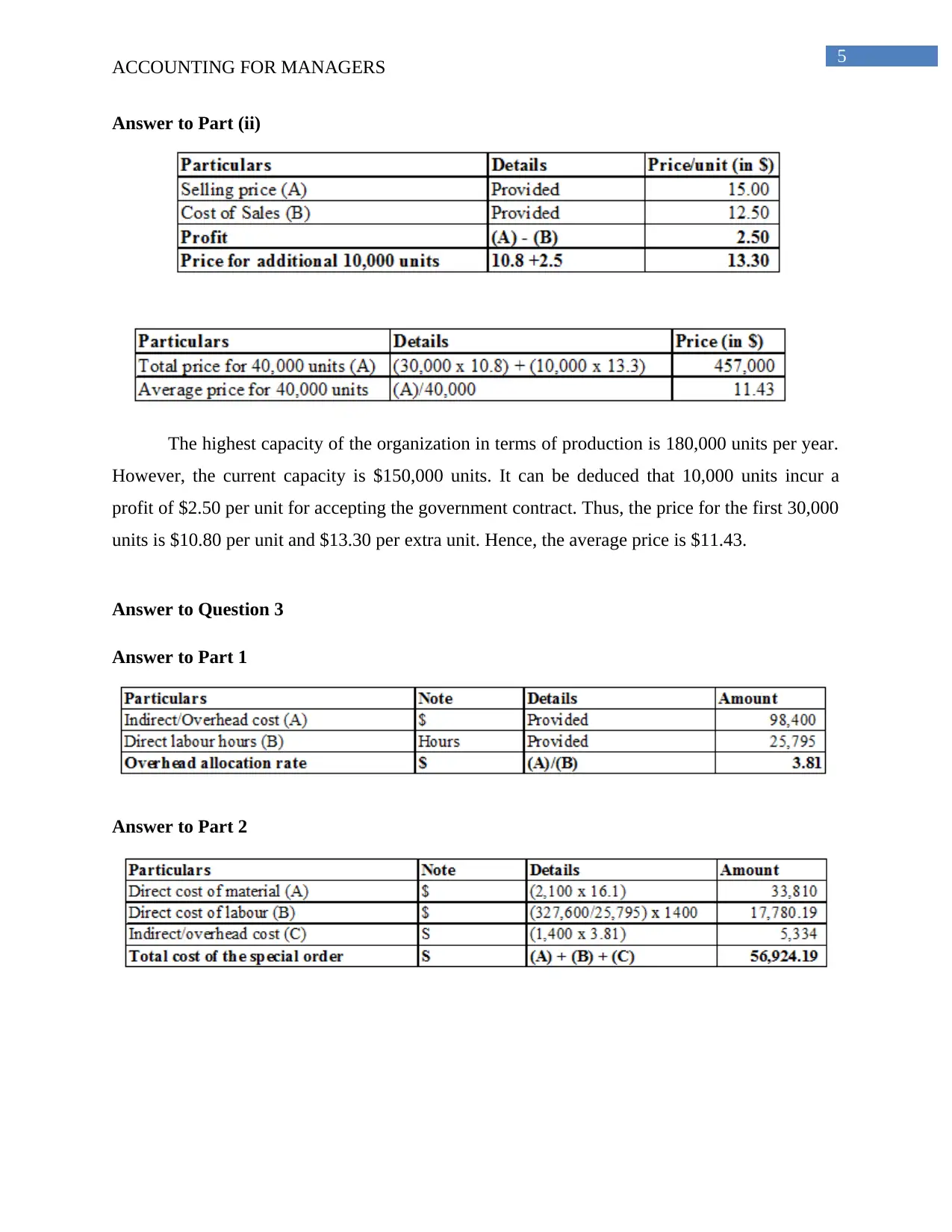
5
ACCOUNTING FOR MANAGERS
Answer to Part (ii)
The highest capacity of the organization in terms of production is 180,000 units per year.
However, the current capacity is $150,000 units. It can be deduced that 10,000 units incur a
profit of $2.50 per unit for accepting the government contract. Thus, the price for the first 30,000
units is $10.80 per unit and $13.30 per extra unit. Hence, the average price is $11.43.
Answer to Question 3
Answer to Part 1
Answer to Part 2
ACCOUNTING FOR MANAGERS
Answer to Part (ii)
The highest capacity of the organization in terms of production is 180,000 units per year.
However, the current capacity is $150,000 units. It can be deduced that 10,000 units incur a
profit of $2.50 per unit for accepting the government contract. Thus, the price for the first 30,000
units is $10.80 per unit and $13.30 per extra unit. Hence, the average price is $11.43.
Answer to Question 3
Answer to Part 1
Answer to Part 2
⊘ This is a preview!⊘
Do you want full access?
Subscribe today to unlock all pages.

Trusted by 1+ million students worldwide
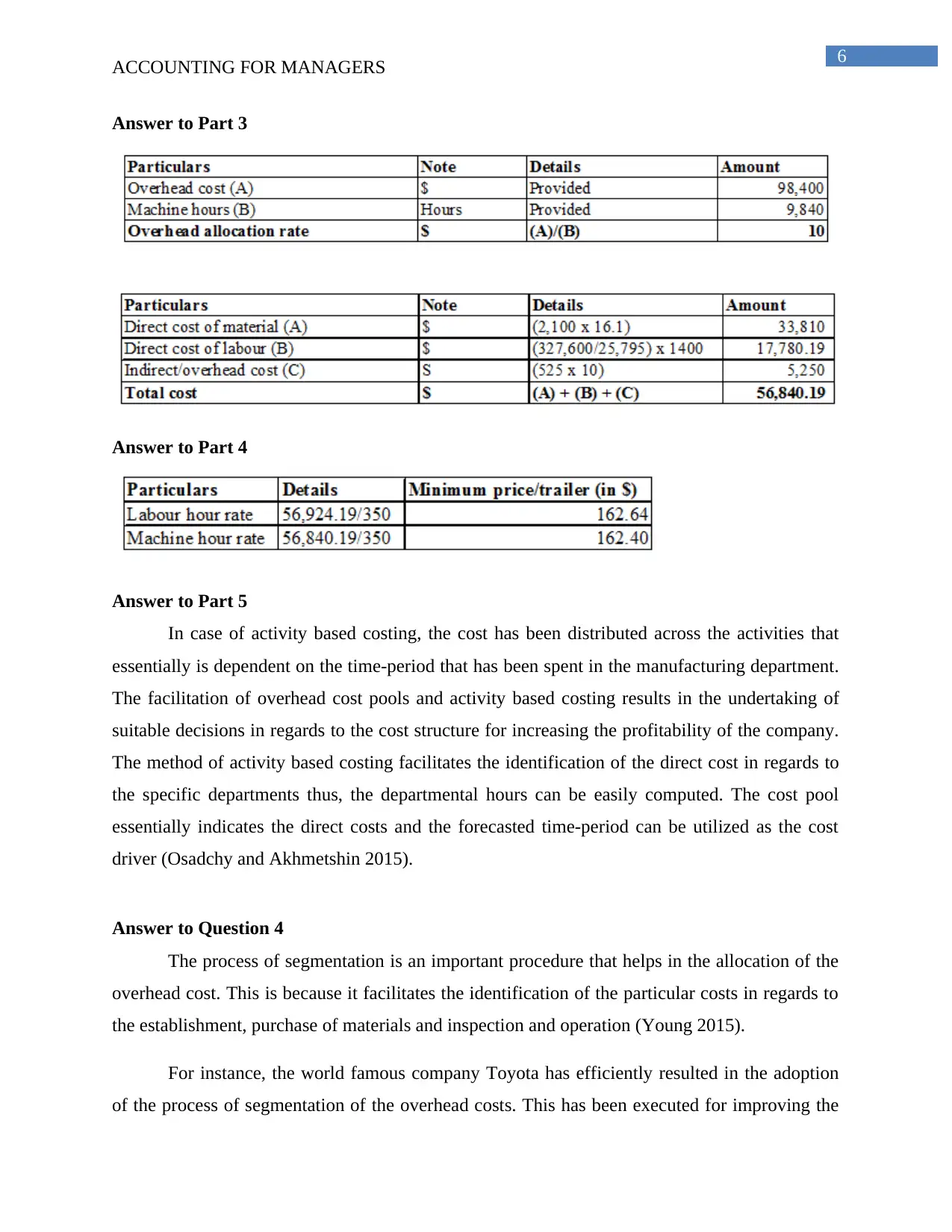
6
ACCOUNTING FOR MANAGERS
Answer to Part 3
Answer to Part 4
Answer to Part 5
In case of activity based costing, the cost has been distributed across the activities that
essentially is dependent on the time-period that has been spent in the manufacturing department.
The facilitation of overhead cost pools and activity based costing results in the undertaking of
suitable decisions in regards to the cost structure for increasing the profitability of the company.
The method of activity based costing facilitates the identification of the direct cost in regards to
the specific departments thus, the departmental hours can be easily computed. The cost pool
essentially indicates the direct costs and the forecasted time-period can be utilized as the cost
driver (Osadchy and Akhmetshin 2015).
Answer to Question 4
The process of segmentation is an important procedure that helps in the allocation of the
overhead cost. This is because it facilitates the identification of the particular costs in regards to
the establishment, purchase of materials and inspection and operation (Young 2015).
For instance, the world famous company Toyota has efficiently resulted in the adoption
of the process of segmentation of the overhead costs. This has been executed for improving the
ACCOUNTING FOR MANAGERS
Answer to Part 3
Answer to Part 4
Answer to Part 5
In case of activity based costing, the cost has been distributed across the activities that
essentially is dependent on the time-period that has been spent in the manufacturing department.
The facilitation of overhead cost pools and activity based costing results in the undertaking of
suitable decisions in regards to the cost structure for increasing the profitability of the company.
The method of activity based costing facilitates the identification of the direct cost in regards to
the specific departments thus, the departmental hours can be easily computed. The cost pool
essentially indicates the direct costs and the forecasted time-period can be utilized as the cost
driver (Osadchy and Akhmetshin 2015).
Answer to Question 4
The process of segmentation is an important procedure that helps in the allocation of the
overhead cost. This is because it facilitates the identification of the particular costs in regards to
the establishment, purchase of materials and inspection and operation (Young 2015).
For instance, the world famous company Toyota has efficiently resulted in the adoption
of the process of segmentation of the overhead costs. This has been executed for improving the
Paraphrase This Document
Need a fresh take? Get an instant paraphrase of this document with our AI Paraphraser
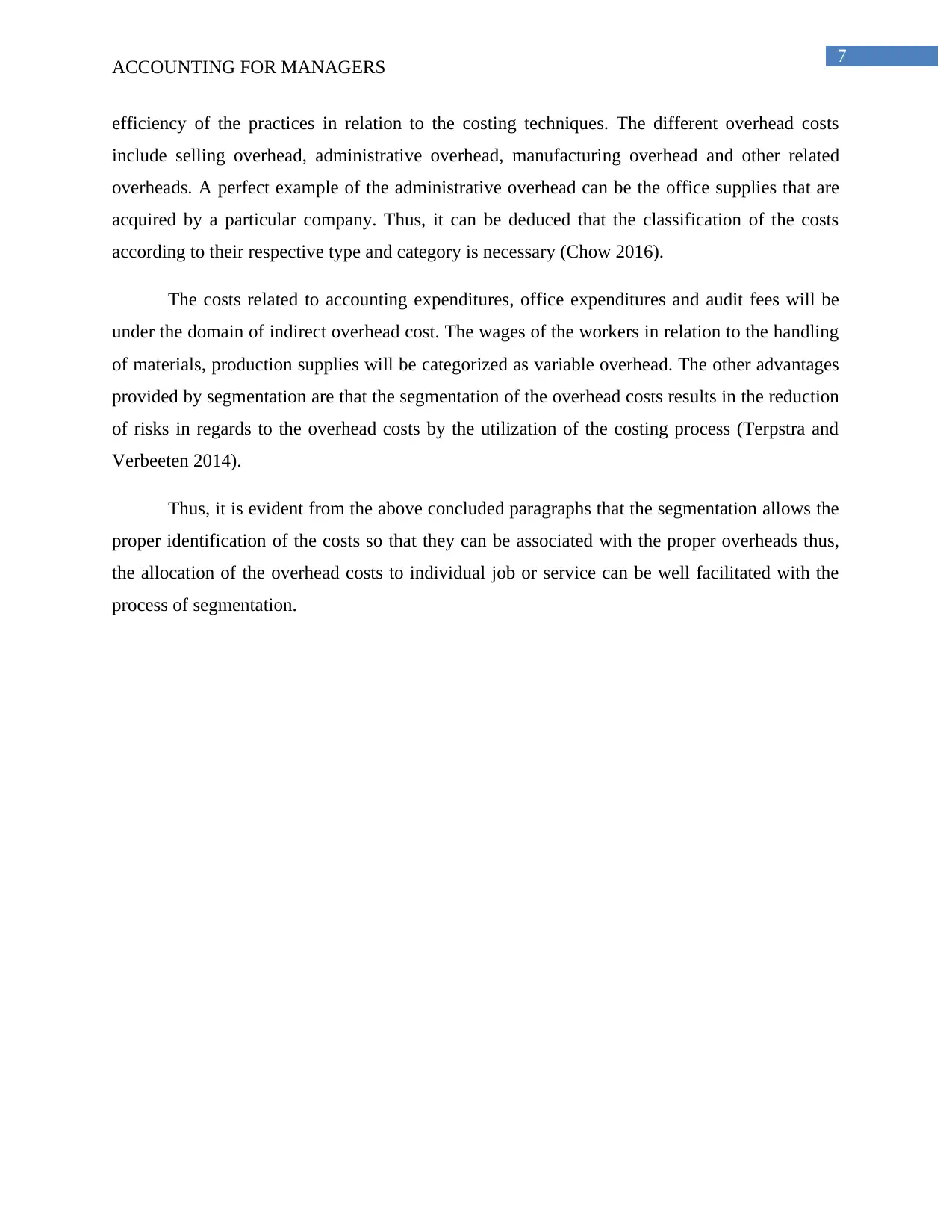
7
ACCOUNTING FOR MANAGERS
efficiency of the practices in relation to the costing techniques. The different overhead costs
include selling overhead, administrative overhead, manufacturing overhead and other related
overheads. A perfect example of the administrative overhead can be the office supplies that are
acquired by a particular company. Thus, it can be deduced that the classification of the costs
according to their respective type and category is necessary (Chow 2016).
The costs related to accounting expenditures, office expenditures and audit fees will be
under the domain of indirect overhead cost. The wages of the workers in relation to the handling
of materials, production supplies will be categorized as variable overhead. The other advantages
provided by segmentation are that the segmentation of the overhead costs results in the reduction
of risks in regards to the overhead costs by the utilization of the costing process (Terpstra and
Verbeeten 2014).
Thus, it is evident from the above concluded paragraphs that the segmentation allows the
proper identification of the costs so that they can be associated with the proper overheads thus,
the allocation of the overhead costs to individual job or service can be well facilitated with the
process of segmentation.
ACCOUNTING FOR MANAGERS
efficiency of the practices in relation to the costing techniques. The different overhead costs
include selling overhead, administrative overhead, manufacturing overhead and other related
overheads. A perfect example of the administrative overhead can be the office supplies that are
acquired by a particular company. Thus, it can be deduced that the classification of the costs
according to their respective type and category is necessary (Chow 2016).
The costs related to accounting expenditures, office expenditures and audit fees will be
under the domain of indirect overhead cost. The wages of the workers in relation to the handling
of materials, production supplies will be categorized as variable overhead. The other advantages
provided by segmentation are that the segmentation of the overhead costs results in the reduction
of risks in regards to the overhead costs by the utilization of the costing process (Terpstra and
Verbeeten 2014).
Thus, it is evident from the above concluded paragraphs that the segmentation allows the
proper identification of the costs so that they can be associated with the proper overheads thus,
the allocation of the overhead costs to individual job or service can be well facilitated with the
process of segmentation.
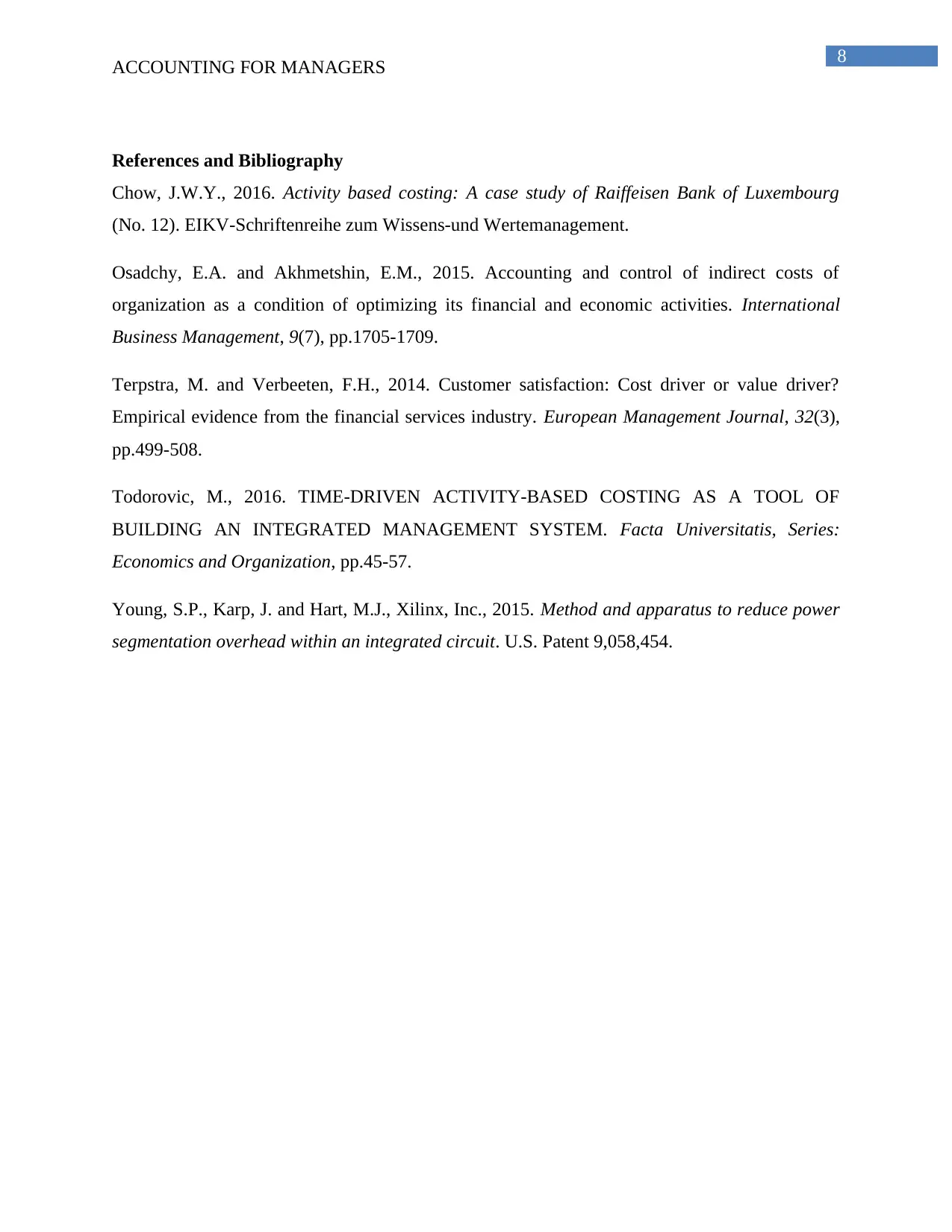
8
ACCOUNTING FOR MANAGERS
References and Bibliography
Chow, J.W.Y., 2016. Activity based costing: A case study of Raiffeisen Bank of Luxembourg
(No. 12). EIKV-Schriftenreihe zum Wissens-und Wertemanagement.
Osadchy, E.A. and Akhmetshin, E.M., 2015. Accounting and control of indirect costs of
organization as a condition of optimizing its financial and economic activities. International
Business Management, 9(7), pp.1705-1709.
Terpstra, M. and Verbeeten, F.H., 2014. Customer satisfaction: Cost driver or value driver?
Empirical evidence from the financial services industry. European Management Journal, 32(3),
pp.499-508.
Todorovic, M., 2016. TIME-DRIVEN ACTIVITY-BASED COSTING AS A TOOL OF
BUILDING AN INTEGRATED MANAGEMENT SYSTEM. Facta Universitatis, Series:
Economics and Organization, pp.45-57.
Young, S.P., Karp, J. and Hart, M.J., Xilinx, Inc., 2015. Method and apparatus to reduce power
segmentation overhead within an integrated circuit. U.S. Patent 9,058,454.
ACCOUNTING FOR MANAGERS
References and Bibliography
Chow, J.W.Y., 2016. Activity based costing: A case study of Raiffeisen Bank of Luxembourg
(No. 12). EIKV-Schriftenreihe zum Wissens-und Wertemanagement.
Osadchy, E.A. and Akhmetshin, E.M., 2015. Accounting and control of indirect costs of
organization as a condition of optimizing its financial and economic activities. International
Business Management, 9(7), pp.1705-1709.
Terpstra, M. and Verbeeten, F.H., 2014. Customer satisfaction: Cost driver or value driver?
Empirical evidence from the financial services industry. European Management Journal, 32(3),
pp.499-508.
Todorovic, M., 2016. TIME-DRIVEN ACTIVITY-BASED COSTING AS A TOOL OF
BUILDING AN INTEGRATED MANAGEMENT SYSTEM. Facta Universitatis, Series:
Economics and Organization, pp.45-57.
Young, S.P., Karp, J. and Hart, M.J., Xilinx, Inc., 2015. Method and apparatus to reduce power
segmentation overhead within an integrated circuit. U.S. Patent 9,058,454.
⊘ This is a preview!⊘
Do you want full access?
Subscribe today to unlock all pages.

Trusted by 1+ million students worldwide
1 out of 9
Related Documents
Your All-in-One AI-Powered Toolkit for Academic Success.
+13062052269
info@desklib.com
Available 24*7 on WhatsApp / Email
![[object Object]](/_next/static/media/star-bottom.7253800d.svg)
Unlock your academic potential
Copyright © 2020–2025 A2Z Services. All Rights Reserved. Developed and managed by ZUCOL.





